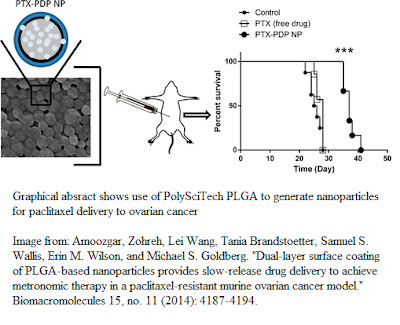PolySciTech (www.polyscitech.com) provides a wide
array of PLGA and related products. PLGA degradation speed depends on
lactide:glycolide ratio as well as molecular weight. PLGA’s with lower lactide
ratios, down to 50%, and lower molecular weights tend to degrade faster as
water easily gains access to the relatively short polymer chain and cleaves it
into little pieces. Recently one of Akina’s fastest degrading polymers AP037
(PLGA 50:50 Mn 1000-5000) was combined with a very slow degrading PLGA with
high molecular weight to create a nanoparticle which had controlled release
properties of paclitaxel. This system was found to be less susceptible to cells
developing resistance as there was less drug-free time periods in between
doses. Read more: Amoozgar, Zohreh, Lei Wang, Tania Brandstoetter, Samuel S.
Wallis, Erin M. Wilson, and Michael S. Goldberg. "Dual-layer surface
coating of PLGA-based nanoparticles provides slow-release drug delivery to
achieve metronomic therapy in a paclitaxel-resistant murine ovarian cancer
model." Biomacromolecules 15, no. 11 (2014): 4187-4194. http://pubs.acs.org/doi/abs/10.1021/bm5011933
Blog dedicated to answering technical questions in an open format relating to PolySciTech (A division of Akina, Inc.) products.
Friday, August 21, 2015
PLGA from PolySciTech used in developing metronomic delivery of PTX to treat ovarian cancer
Subscribe to:
Post Comments (Atom)

No comments:
Post a Comment